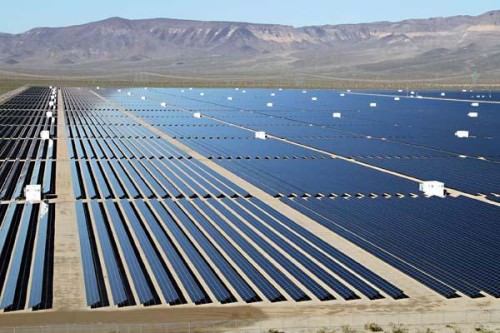 Boulder City, Nevada has found a new way to
Boulder City, Nevada has found a new way to
pay off its debt: solar power. The city is
home to not only Hoover Dam, but two of the largest solar power
plants in the United States, Copper Mountain Solar I (58 megawatts)
and Nevada Solar One (65MW). Both solar facilities are leased on
land owned by Boulder City in a specially designated "energy
zone."
Combined, these solar
lease payments provide at least $12 million a year, increasing
Boulder City's revenue by 50 percent. Since the leases last 20
years, Boulder City is expected to obtain $480 million in rent
revenue. By comparison, in 2011, the city's total debt
burden topped $96 million. If its spending levels don't increase
(granted, a big if), the city could eventually eliminate its entire
debt.
However, it's not always sunny in Nevada. Both solar facilities
are pitiful sources of
green jobs. Although they did create hundreds of temporary
construction jobs, Nevada Solar One now employs only
30 people, while Copper Mountain Solar I has
only 5 full-time positions.
Still, thanks to minimal regulations, both Copper Mountain Solar
I and Nevada Solar One are expanding, while three Korean companies
are finalizing plans for new solar projects. All together, these
projects aim could soon have 1.4 GW of capacity, which could
power 420,000 homes. (And unlike
Germany, Nevada actually has sunlight.)

Since the land is owned locally by Boulder City, these firms can
bypass the onerous Bureau of Land Management. One Korean investor
explains:
The bureau's environmental impact studies take three or four
years and the permits cost ($5 million to $6 million)...Boulder
City did its due diligence in terms of who they do business with
and the environmental impact, but the fact Boulder City doesn't
require the environmental studies makes it a very preferable
situation for Boulder City and the solar companies.
Unfortunately, this is rather rare in Nevada, since the federal
government
owns almost 85 percent of that state's land.
In addition, with no state corporate or individual income taxes,
Nevada has the 2nd lowest tax
burden in the United States, while its business tax climate
ranks 3rd nationwide, according to the Tax Foundation. By
comparison, neighboring California ranks 48th. In addition, Sempra
Generation (the energy company behind Copper Mountain Solar I), was
further enticed by state tax
policies:
Incentives amounting to $12m came in the form of sales tax
abatements for equipment purchases and a 55% property tax reduction
for 20 years. These incentives were provided by the state
officials.
Meanwhile, on the federal level, the devlopers of both projects
were able to keep more of their money, thanks to the federal
investment tax credit (ITC)
program. This provides a 30 percent tax credit on a renewable
energy project, which deducts the total amount of taxes owed to the
federal government.
Of course, the ITC and other narrow tax policies still
constitute a form of political favoritism. The best course of
action would be to repeal all of these energy tax breaks
and deductions, and lower rates for everyone. Speaking of which,
this precisely is what Sen. Jim DeMint
(R-SC) and Rep. Mike Pompeo (R-KS)
hope to do with their new
bill, the Energy
Freedom & Economic Prosperity Act. Boulder City, Nevada is
proof that low taxes, minimal red tape and federalism can boost a
local economy.
Reason on solar power. For more on
tax breaks, be sure to read A. Barton Hinkle on
"The Difference Between a Tax Break and a Subsidy." And if you
want to know more
about municipal debt crises (as well as Portland microbrews and the
Plastic People of the Universe), get a
copy of The Declaration of Independents: How Libertarian
Politics Can Fix What's Wrong with America.